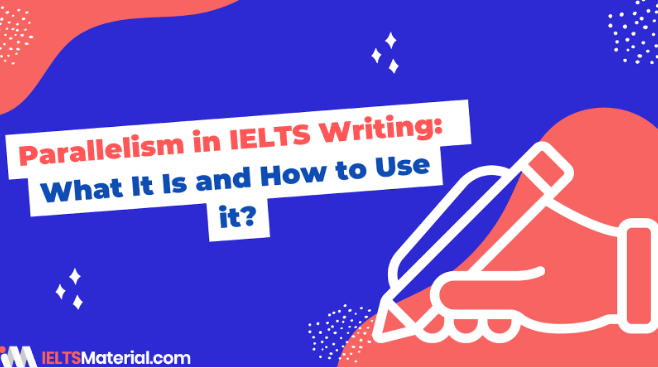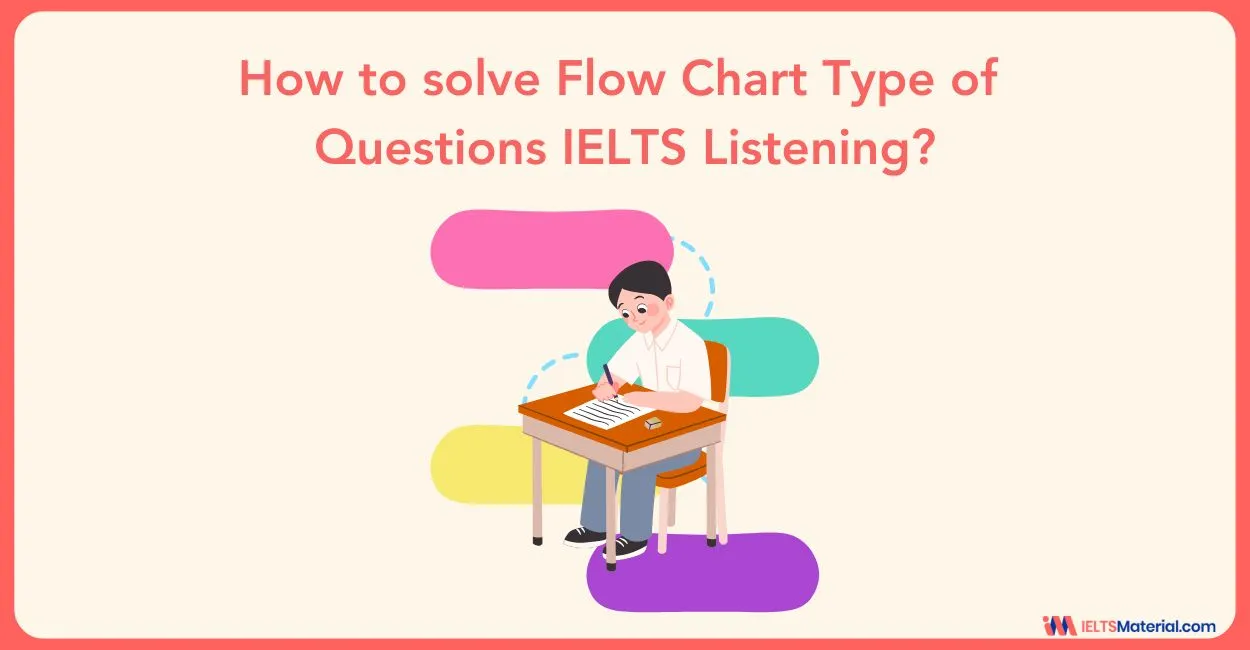Parallelism in IELTS Writing: What It Is and How to Use it?
5 min read
Updated On
-
Copy link
Table of Contents

Limited-Time Offer : Access a FREE 10-Day IELTS Study Plan!
Introduction
Parallelism is a lesser-known grammatical concept that is not often taught in English lessons. It is also not a common topic in many English textbooks. However, parallelism can be a very useful tool for IELTS Writing.
When it comes to excelling in the IELTS Writing section, it is important to use effective writing techniques. One such technique that can greatly improve your writing is called parallelism.
Parallelism helps to make writing more structured and organized. Also, the IELTS examiners look for writers who can use language effectively and fluently.
In this blog, let’s delve and understand what parallelism is, why it is important in IELTS Writing, and how you can use it to improve your own writing. So, let’s begin this exploration of precise and persuasive language!
What is Parallelism?
Parallelism is a literary device that refers to the use of similar grammatical structures in a series of words, phrases, or clauses. This can be used to create a sense of balance and rhythm in your writing, as well as to make your points more clear and concise.
For example, the following sentence uses parallelism: I enjoy reading, writing, and listening to music.
In this sentence, the three verbs (reading, writing, and listening) are all in the infinitive form. This creates a sense of balance and rhythm in the sentence, making it easier to read and understand.
Why is Parallelism Important in IELTS Writing?
There are a few reasons why parallelism is important in IELTS Writing.
Parallelism Boosts IELTS Writing:
Parallelism can help you achieve a high band score in the IELTS Writing exam by making your writing more structured and organized.
For Example:
Non-parallel: I enjoy reading, to watch movies, and going for walks.
Parallel: I enjoy reading, watching movies, and going for walks.
Enhancing Clarity & Conciseness through Parallelism:
Parallelism can help you make your points more clear and concise. By using similar grammatical structures, you can create a sense of balance and rhythm in your writing, which makes it easier for the reader to follow your train of thought.
For Example:
Non-parallel: His presentation was informative, engaging, and he organized it well.
Parallel: His presentation was informative, engaging, and well-organized.
Adding Flair and Variety to Your Writing with Parallelism:
With parallelism bringing variety to your writing, you can use parallel structures consistently and prevent repetitive grammatical structures. This adds an element of interest and engagement to your writing, making it more engaging for the reader.
For Example:
Non-parallel: She danced with grace, sang passionately, and had an imaginative painting style.
Parallel: She danced with grace, sang with passion, and painted with imagination.
How to Use Parallelism in Your IELTS Writing?
There are a few different ways to use parallelism in your IELTS Writing. One way is to use it in lists. For example, you could write a list of your favorite hobbies, using parallelism to ensure that all of the verbs are in the same grammatical form.
Example 1:
Non-parallel: My hobbies include reading, swimming, and to go for long walks.
Parallel: My hobbies include reading, swimming, and going for long walks.
Example 2:
Non-parallel: In my free time, I enjoy hiking, playing tennis, and to listen to music.
Parallel: In my free time, I enjoy hiking, playing tennis, and listening to music.
Another way to use parallelism is to use it in sentences that compare or contrast two or more things. For example, you could write a sentence that compares the benefits of two different types of exercise, using parallelism to ensure that the two clauses are structured in the same way.
Example 1:
Non-parallel: Running improves cardiovascular health more than to lift weights enhances muscle strength.
Parallel: Running improves cardiovascular health more than lifting weights enhances muscle strength.
Example 2:
Non-parallel: Studying alone helps in concentration, while to work in groups boosts collaboration skills.
Parallel: Studying alone helps in concentration, while working in groups enhances collaboration skills.
Also Read: Improve your Writing Skills with Parallelism
Tips for using parallelism in IELTS Writing:
By using parallelism in your IELTS writing, you can improve the clarity and conciseness of your writing, make your writing more engaging and readable, and demonstrate your understanding of English grammar. So, here are some tips for using parallelism in IELTS writing:
- Use the same grammatical structure for all items in the list or series. For example, if you are listing a series of verbs, all of the verbs should be in the same tense and form.
- Example: She ate, slept, ran, and played.
- Use the same conjunctions for all items in the list or series. For example, if you are using a list of adjectives, all of the adjectives should be connected by the same conjunction, such as “and” or “or.”
- Example: The cat is friendly, affectionate, and playful.
- Make sure that the parallel structures are balanced and symmetrical. This means that the structures should be of equal length and weight.
- Example: The teacher explained the lesson, answered the students’ questions, and gave them homework.
- Use parallelism to emphasize important points. When you want to emphasize a particular point in your writing, you can use parallelism to make it stand out.
- Example: The most important things in life are love, health, and happiness.
- Use parallelism to create a sense of rhythm and flow in your writing. Parallelism can help to create a sense of rhythm and flow in your writing, which can make it more enjoyable to read.
- Example: The wind blew through the trees, the leaves danced in the breeze, and the birds sang in the sky.
- Use parallelism to create a sense of balance and symmetry in your writing. Parallelism can help to create a sense of balance and symmetry in your writing, which can make it more aesthetically pleasing.
- Example: The old man sat on the bench, watching the children play, and enjoying the sunshine.
Also Read: 6 Useful Tips to Improve IELTS Writing Skills
An IELTS Example Of Parallelism
Parallelism is especially important in IELTS writing, as it can help you to produce clear, concise, and effective essays. So, here are some IELTS examples of parallelism.
Example 1:
Original: The chart illustrates the number of cars sold in four different regions: Europe, Asia, North America, and Australia.
Parallel: The chart illustrates the number of cars sold in Europe, Asia, North America, and Australia.
Example 2:
Original: The graph shows the number of people who visited the museum in the past five years. The number of visitors increased steadily from 2015 to 2017, but it decreased in 2018 and 2019.
Parallel: The graph shows that the number of museum visitors increased steadily from 2015 to 2017, but it decreased in 2018 and 2019.
Conclusion:
Incorporating parallelism into your IELTS Writing can significantly enhance the quality and impact of your work. Its ability to improve clarity, flow, emphasis, consistency, and memorability makes it an invaluable tool for any aspiring IELTS test-taker.
Using parallelism in your writing can help you make it more structured, organized, clear, concise, and interesting. It can also help you achieve the desired band score in IELTS. Hence, include parallelism as a key element in your IELTS preparation.
So, what are you waiting for? Start using parallelism today!
Frequently Asked Questions
What is parallelism and why is it used?
Why should you use parallelism in your writing?
What is parallelism in writing examples?
What is the rule of parallelism?
Give one example of IELTS Example Of Parallelism.
Explore IELTS related articles

Start Preparing for IELTS: Get Your 10-Day Study Plan Today!
Recent Articles

Nehasri Ravishenbagam

Nehasri Ravishenbagam

Haniya Yashfeen





Post your Comments